We said that we would let fate decide where we went next and it decided that it was going to get all schizophrenic on us and send us to Honduras, via El Salvador, which, as only Honduras shares a border with Nicaragua, is geographically impossible. One of our options in Leon was to get a Tica Bus, Central America’s equivalent to National Express/Greyhound to take us to San Salvador. But after a quote of $35 per person we decided to mock fate by doing a short loop into eastern El Salvador before heading back up into Honduras to see its sites. However, fate isn’t going to make it easy for you when you taunt it, so after 12 hours of travel, 10 changes of transport through 3 countries but at a cost of only $17 between the two of us we arrived at .......... well this is the Honduras blog so you’ll have to wait until the El Salvador blog to find out where we went first ;)
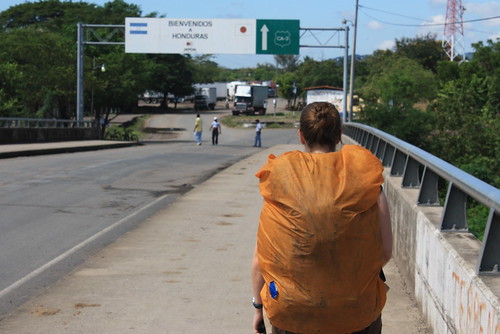
Ruta Lenca
Our route into Honduras took us through the region of the indigenous Lenca people who are known for their colourful head scarves. The region was certainly off the beaten track and the only fellow travelers we saw were the ones that we had met in El Salvador and were making the journey with. The locals, who probably don’t see many tourists, thought three 6 foot plus men were modern day giants, but that didn’t stop them squeezing us along with another 20 people into a 13 seat mini van! It also didn’t help that the roads were some of the worst we have seen since Asia, but the scenery through the mountains was spectacular as were the colourful market towns of Marcala and La Esperanza.
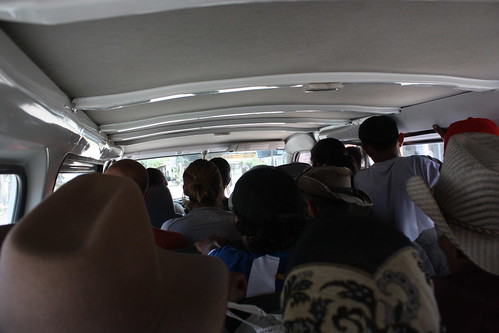
Gracias
Despite the cramped conditions we arrived safely in Gracias, which, when known as Gracias a Dios ‘Thanks to God’, was the capital of Spanish Central America. Maybe the almighty took exception to the name shortening as today its no more than a slightly run down colonial hill town. Its claim to fame should be the worlds coldest showers outside of the Arctic. At Hotel Erick, I think they chill the water as it is so ice cold it burns and takes your breath away when you finally brave the water. But it was in Gracias we became reacquainted with an old friend, the tuk-tuk moto taxi.
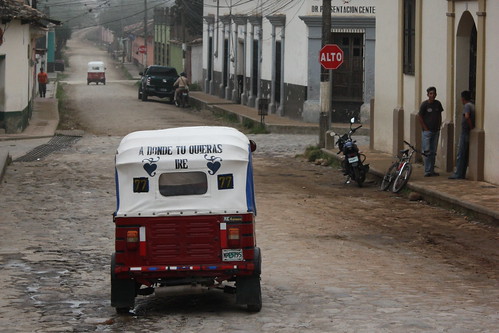
From Gracias we again had our pain thresholds tested when the conductor decided that the already over filled mini van was able to squeeze another two very large ladies onto our row of seats. Then with no room to move, he decided to let the obligatory fried chicken seller on too! Again when I could open my eyes from the pain and see through the mountain of bodies, the views as we wound our way through the hills and a national park were breathtaking, or maybe I just couldn’t breathe due to being squashed. Thankfully I was revived by the local brew, a real lifesaver!

Copán Ruinas
Archaeological evidence suggests the Maya civilization, one of, if not the greatest civilization in the ancient world, started building ceremonial architecture approximately 3,000 years ago and from about 400-800 AD Copán was a capital city of one of its kingdoms. Like many Inca ruins Copán was reclaimed from the jungle and the ruins made from volcanic tuff follow the Maya tradition of architectural relationships built to mirror their cosmos, building repeatedly on the same spot, using similar patterns and rituals.
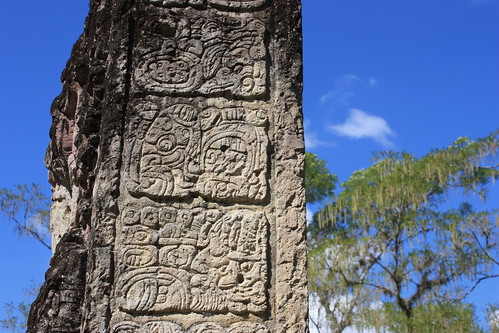
Copán contains the most elaborate sculptural style known of the Maya world, with its sculptures depicting the royal genealogy, history and rituals of its 16 rulers. Most depict the 13th King under whom the Copán kingdom came to prominence, Uaxaclahun Ubak K’awil thankfully also known as 18 Rabbit.
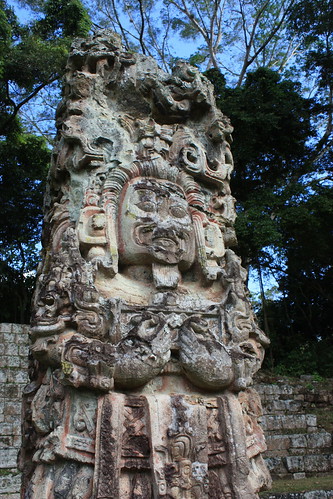
It also contains the most extensive example of Maya hieroglyphic writings and perhaps the sites most impressive attraction is a stairway of 63 steps, containing over 7000 glyphs immortalising the achievements of Copán’s realm. Even though it was sheltered under a tarp to protect it from the elements, you could still appreciate the workmanship that went into it and how magnificent a structure it is.
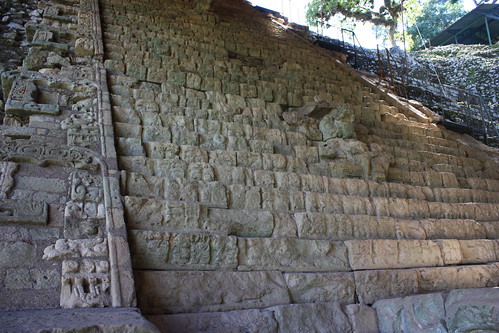
The site also contains a ball court where a traditional Maya game was played, although the rules and object of the game are unclear, what is known is that the loser lost their head, literally! Despite the gory and bloody nature, Copán was a great introduction to Maya civilization and the other ruins we're looking forward to visiting in the region.

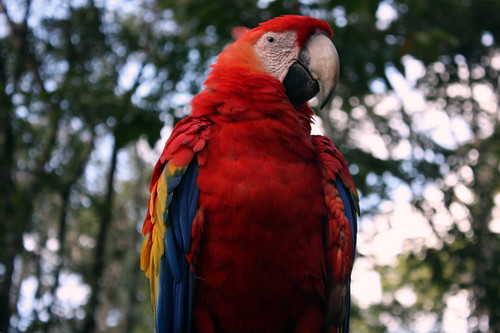
While in Copán, Jo heard good reviews about the Guacamaya Spanish School, so she decided that she would stay in the sleepy town to go back to school for a week to iron out a few bad language habits and improve her conversational skills, while I headed north to improve my diving skills.

Utila
Columbus named Honduras, meaning ‘depths’, due to the waters off its north coast. This topography has made the Bay Islands one of the worlds premier dive destinations, so I went to Utila to see them for myself. I left early in the morning to try to avoid the crowds, but thankfully the transport was a proper coach with plenty of leg room, which was needed for the 10 hour journey. After catching the hour long ferry I set foot on Utila and any thoughts that it was going to be like Little Corn quickly disappeared when I was nearly run over by the many scooters, quad bikes and golf carts that plow down the main strip, despite the islands small size.
I haggled with Utila Dive Centre for 12 dives for the price of 10, with free accommodation and although the accommodation was only a dorm bed, for all but the first night I had a room to myself. Due to the deep channels around Utila it is known to be a reliable spot for seeing whale sharks and although I knew before heading to the islands that it wasn’t the right season I was told there had been a couple of sightings in the days leading up to my arrival , so I got up every morning at 6.30 to go diving. Unfortunately it wasn’t to be, but I still had some great dives and got to see lots of other aquatic life, including but not limited to Eagle Rays, Green Moray Eels, Cow fish and also doing my first wreck dive.
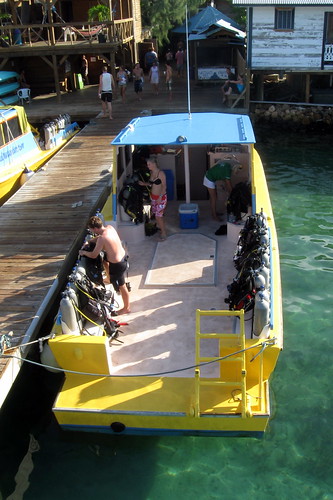
I also teamed up with some Germans and a Dutch group that I met on the ferry and played an afternoon game of pick up football with some local lads.
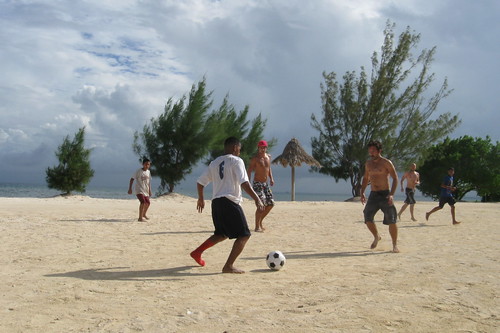
The beach on Utila was small but was also used by the local girls to teach young pups how to swim!
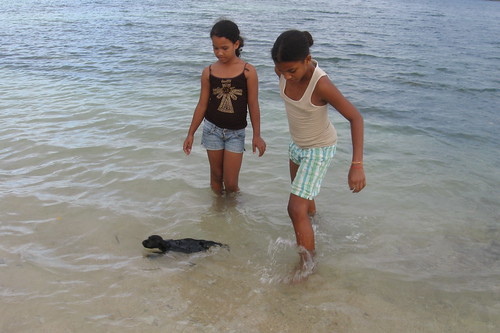
Most of my evenings were spent fishing with Felix and Frieder over a few beers. We were hoping to catch some bonito (tuna) that we could turn into a cheap dinner but all we caught were some small bait fish, along with a moray eel and a southern stingray that we needed a locals help with setting free, although we’re all glad that we didn’t catch the huge porcupine fish we saw angling for our bait one evening.
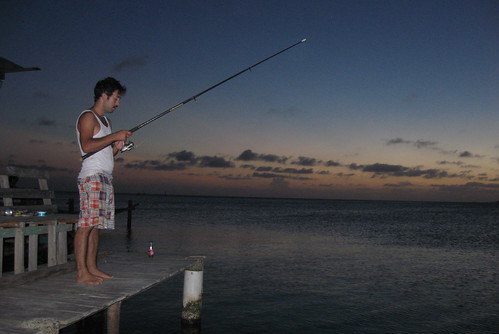
After saying goodbye to Utila I headed back to meet Jo in Copán so we could continue our travels back into El Salvador.
Honduras Summary
The food in Honduras, once you manage to get your head around the fact that breakfast and dinner are the same meal, deserves a special mention. The pupusas and baleadas eaten at all times of the day are deliciously addictive, and where else in Central America do bus food vendors sell complete meals on a plate wrapped in cling film?
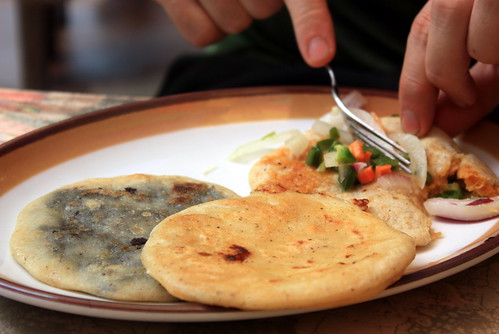
There's a lot of gang and gun crime problems in the whole of Central America, but it was in Honduras where we encountered or first gun and gun repair shops, which was slightly unnerving the first few times we saw them. But seriously who needs to buy a gun at a bus station?
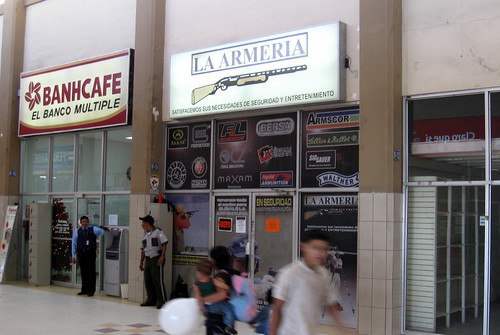
I don’t think that I have felt scruffier in any of the countries we have visited than I have in Honduras, where, despite the heat, the locals all wear trousers with nice polished shoes. Along with wearing cowboy hats and carrying machetes they all wear the customary bigotes (moustaches) even when some of them look more like a fuzzy caterpillar on their top lip.

Highlights
Favourite Place - Copán (Jo) Utila (Ryan)
Favourite Attraction - Copán Ruinas (Both)
Favourite Food - Pupusas (Jo) Baleadas (Ryan)
Favourite Beer - Salva Vida (Ryan)
Favourite Drink - Horchata - a rice and cinnamon cold drink (Jo)
Lowlights
Being kneecapped on each bus journey
For those of you thinking of possibly traveling to the region: Costs in USD
Accommodation - $10 for a private room in hostel
Restaurant meal - $3-4
330ml Bottled Beer - $1.25
500ml Soft Drink - $0.75
1.5l Bottle of water - $0.75
Bus - $ 1.5 / hour
Ryan y Jo
Photos: http://www.flickr.com/photos/dojo77/